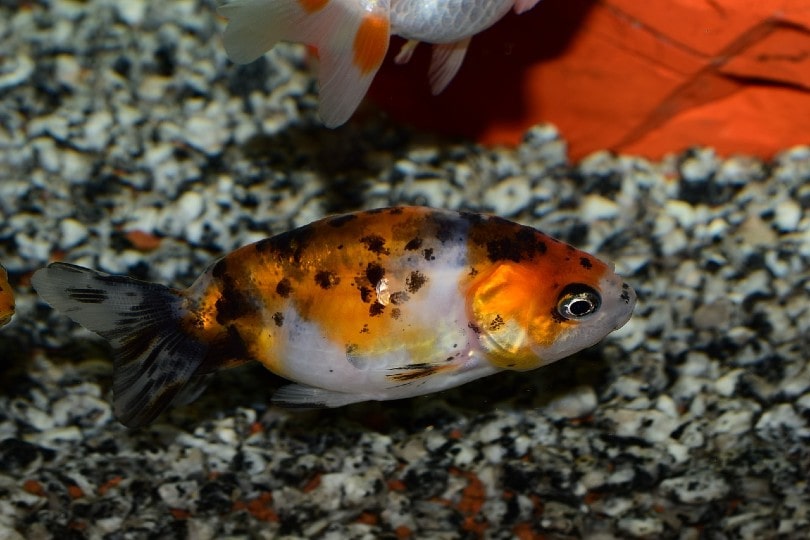Goldfish Sitting at the Bottom of the Tank: Reasons & Solutions

Goldfish are usually bursting with activity and swimming playfully around the tank waiting for their next meal. This makes it concerning when we find our goldfish inactive and lying on the bottom of the tank. This is abnormal goldfish behavior and should not be overlooked. Bottom sitting is typically one of the first signs of an unhealthy or unhappy goldfish. Ignoring this behavior can lead to your goldfish getting worse health-wise or even lead to their passing.
It is best to find the source of the problem, whether it is a disease or not. There is always a root cause for bottom sitting and if caught early your goldfish is more likely to make a full recovery.
This article will inform you on the different reasons your goldfish may be bottom-sitting and how to effectively determine a solution.

Bottom-sitting in Goldfish
There are many factors to consider when your goldfish is acting inactive and lethargic along the bottom of their tank. This concerning behavior is displayed as a goldfish hovering or lying down with its stomach on the substrate. They may or may not have clamped fins and this is a sign your goldfish is not feeling too good. Your goldfish may also develop sores on the bottom of the stomach if the rough substrate is cutting into their scales the whole time. This will be seen as red blotches on the stomach. Your goldfish may lay at the bottom of the tank for short or long periods, all of which are concerning.
8 Reasons That Goldfish Bottom-sit (with Solutions)
1. Stress
A stressed goldfish is generally unhealthy and will become lethargic. A stressed goldfish may have its fins partially clamped and remain inactive in the tank. This behavior usually lasts for short amounts of time and can be combined with erratic swimming and then an unexpected switch to bottom-sitting. Your goldfish can be stressed for a variety of reasons, such as dirty water, an unsuitable tank mate, living in a bowl, or other small spherical aquaria.

2. Disease
One of the most common explanations for a goldfish bottom-sitting is an underlying illness. This can be an enormous amount of disease, infections, or disorders that are not always identifiable in the early stages. Once you notice a sign of disease in your goldfish, you should take immediate action.
3. Boredom
If your goldfish is housed inside of a bowl, vase, bio-orb, or tall cylindrical tank, not only are they being housed inadequately, but it also causes boredom. A goldfish in small aquaria will have minimal room to swim and explore. As a result, they will sulk at the bottom of the tank and generally become uninterested in normal goldfish activities.
4. Poor Water Quality
If you do not keep up with water changes or provide your goldfish with a quality filtration system, they will get ill or stressed from poor water conditions. This is a matter that should be dealt with as quickly as possible to keep the goldfish from getting worse. Poor water quality causes nitrate, ammonia, or nitrite poisoning, and it is deadly.
If you are looking for help to get the water quality just right for your goldfish family in their aquarium, or just want to learn more about goldfish water quality (and more!), we recommend you check out the best-selling book, The Truth About Goldfish, on Amazon today.

It covers everything from water conditioners to tank maintenance, and it also gives you full, hard copy access to their essential fishkeeping medicine cabinet!
5. Suffocation
Goldfish in tall tanks or in tanks that are too warm or lack an aeration system will start to slowly suffocate in their tank. This is a huge concern that can quickly yet painfully take the life of your goldfish. Your goldfish may be so lethargic and tired that they give up on gulping oxygen from the surface and instead they slowly suffocate at the bottom of the tank. You may also notice rapid gill movement and gasping while they lay at the bottom.

6. Inadequate Diet (Deficiency)
Goldfish can suffer when they are kept on a low-quality diet with not variety. Goldfish require a high amount of protein with balanced levels of fiber and fat. They should also be fed a mixture of foods alongside their staple commercial diet. Over time, a low-quality diet will cause them to develop poorly and appear deformed. They will also not have enough energy to swim around the tank. In bad cases, their organs may begin to shut down and they will develop dropsy.
7. Environmental Distress
If your goldfish is kept in an environment that regularly experiences loud noises, vibrations, or just general boisterous human activity it can easily become startled and stressed. This will make them seek out shelter under a decoration or plant and lay on the group underneath it.
8. Swim Bladder Disorder
Goldfish can suffer from problems with their swim bladder that inflates and deflates air for bouency purposes. If the goldfish is struggling to swim and keeps sinking to the bottom of the tank, it could have a potential swim bladder disorder. The fish will need immediate treatment depending on what caused this bout of swim bladder issues. It can be related to genetics, feeding amount, and digestion.
9. Parasites
Parasites can wreak havoc on your goldfish’s body. The result of long-term parasite exposure can lead to all sorts of health issues for your goldfish. Parasites can cause a variety of diseases in goldfish that will cause them to lay on the bottom of the tank. There will be symptoms of parasites in your goldfish if this is the reason that they are bottom sitting.

10. Digestion Issues
This is a common occurrence in fancy goldfish because of their rounded bodies and compressed organs. They will have trouble digesting their food as well as effectively passing their waste. This can be a painful issue and will cause them to bottom sit while they are trying to pass waste, or it can sometimes occur after they eat.

Conclusion
Now that we have discovered the main causes of why goldfish bottom-sit, it will be easier to make a diagnosis and effectively treat the goldfish. It is always a good idea to regularly check how your goldfish is acting within the tank so you can catch any problems early on. The sooner you start treating your goldfish, the more likely they are to bounce back from their health issue.
Featured Image Credit: Fourpawspics, Shutterstock



Không có nhận xét nào